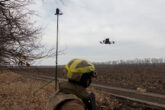December 04, 2014
Talk Stealthy to Me
As the Air Force Times recently reported, the F-22 and F-35A conducted their first integrated training mission earlier this month. Several observers declared this mission, which included offensive counter air, defensive counter air and interdiction operations, to be a success. But if the planes are to actually operate as a cohesive strike package in the complex A2/AD environments of the future, the services will first need to address a glaring gap in interoperability: data links.
Currently, the F-22 and F-35 are equipped with two different low probability-of-intercept/low probability-of-detection (LPI/LPD) systems for exchanging data while in stealth mode: the F-22 uses the older and more limited Intra Flight Data Link (IFDL); the F-35 operates with the newer Multifunction Advanced Data Link. Quite astoundingly, these two LPI/LPD systems cannot communicate with each other, meaning that if the F-35 and F-22 need to share information with each other, they must do so using the non-stealthy Link 16 system used by 4th-generation legacy aircraft. (And even then, the F-22 is limited to receiving data; it cannot transmit it.)
Read the full article at War on the Rocks.
More from CNAS
-
Defense / Transatlantic Security
When Defense Becomes Destruction: Austria-Hungary’s Mistake and Ukraine’s RiskThis article was originally posted on War on the Rocks. The southeastern Polish city of Przemyśl, with its elegant 19th century Habsburg-era train station, remains one of the ...
By Franz-Stefan Gady
-
Defense / Transatlantic Security
Ukraine’s Catch-22 MomentThis article was originally published in the Financial Times. In Joseph Heller’s wartime classic, Catch-22, the protagonist Yossarian seeks out the US army surgeon Doc Daneeka...
By Franz-Stefan Gady
-
CNAS Insights | Budgetary Own Goals Undermine “Speed and Volume”
On November 7, Secretary of Defense Pete Hegseth laid out a plan to overhaul the Department of Defense’s (DOD’s) acquisition system. Placing an emphasis on delivering new capa...
By Philip Sheers, Carlton Haelig & Stacie Pettyjohn
-
Drones: Who Is Making the New Weapons of War?
From Ukraine and Russia to Gaza and Sudan, drones have become a key weapon of war. Which companies are making them, and profiting from this rapidly expanding but controversial...
By Stacie Pettyjohn




